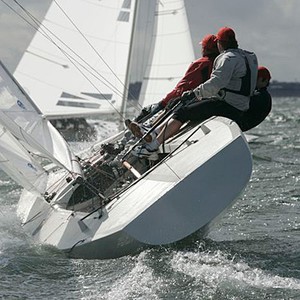Etchells World Championships - The mystery of the Malahide
by Jake Gunther on 15 Sep 2010

"Great location, lots of tactical analysis." Ingrid Abery
http://www.ingridabery.com
Etchells World Championships update: 'Tis just a short story about a place that is full of folk law and local knowledge mysteries.
We were told that there would be things going on out there on the racetrack. Things that only bearded wizards from the dark ages could possibly understand and that basically, unless you had years of local sailing experience, you were in big trouble. Over the years, I have sailed plenty of tidal tracks.
This year, prior to the Worlds, I sailed several major championships in serious tidal conditions, each time becoming more switched on to the intricacies of tidal racecourses. Last Xmas, the Finn Australian National Championships were sailed at the seaside town of Portsea, in my home State of Victoria, in a solid 1-1.5 knot tide.
A heap of help from my dear friend and our Finn Olympic representative, Anthony Nossiter, ensured I was able to put together some really good heats, using the tide to make my life very much easier. He had learnt a lot from Qingdao and it showed in the way he dealt with lay lines and shift potentials.
The big lesson there was that big mistakes come easy in big tide and lots of very good sailors were making plenty of big errors, often enough to be noticed.
The 2009 Etchells New Zealand Nationals were sailed in the river in Auckland Harbour, so you can imagine how that was. Up to two knots of adverse flow under your boat requires some pretty interesting starting techniques. It was there that I firmed up the idea that once you identify a tidal advantage, you then just nail it, don’t fluff around, send the thing into the gain and bank it.
Croatia was a fantastic venue for a World Championship in the Finn and with 170 entries it provided for some amazing sail boat racing. We had a wind driven tide, which was always surprisingly strong and affected every race. If you weren’t onto it, you could loose massive amounts of distance on your competitors. This could never be recouped. I felt I had a pretty good handle on the track by the end of the regatta. I placed fourth as a Grand Master and 14th overall at Split.
Think about this for a tidal conundrum. You leave the start line one third up from the pin, all happy and sitting in the front row at 300 metres out, still all good. The most leeward boat shoots forward as he gets out of the adverse tide and is now 150 metres to leeward and gaining all the time. Both the boats directly above you and below you do nothing. They just keep chugging along, almost oblivious to the gains being made to leeward.
Here comes the big call, then. I reached down behind the front row, with sheet eased and traveller down, until I got to the tide line and bingo, I too was on the magic carpet ride! I had given away 50 metres, but rounded the top mark fourth and the guys that were in the front row back when we were 300 metres out, ended up 200 metres behind!
These were just some of the lessons I took to the Etchells World Championship this year and I am sure they were a massive help in achieving a respectable fifth place in that regatta.
Whilst it was assumed that by moving the racetrack out away from the shore, the tide would be less influential, it was still a very big deciding factor in your first beat planning, however.
We worked with John, Dog and Tom before each race to get a read on things by doing splits and returns, but they were never hugely conclusive. The tide gains and losses generally occurred on the edges and sometimes only in the very top or very bottom of the course. When the gains kicked in, they could be enormous and in some cases you had to wait for the next leg to really take advantage of them.
I have always felt local knowledge to be a bit of a myth, but in this case it was definitely a major handicap. Prior assumption of what was going on, often led to the locals missing the real gains. Sure. Sometimes to know what is supposed to happen is helpful, but when you have a track as complicated as Howth, it is totally 'eyes out of the boat' sailing. During many races in the championship, the first beat provided a confirmation of the tidal influence, which we then nailed home in the next beat.
One of the big lessons I came away from Ireland with, was the importance of the sailing angle over the true breeze. We had plenty of racing with a perpendicular current and the effect of the current on the opposite tacks was major, especially in the light airs. This could affect your start line maths by up to 10 degrees.
So I guess at the end of the day, what I’m saying here is that unless your race track has documents like winning tides to guide you around the buoys, then a clear understanding of tidal potentials is critical.
If the fleet is fairly evenly matched in speed, then large bells should be ringing in your head if gains are being made in specific areas of the course. Sometimes its shifts, sure, but on a tidal racetrack, it often is just a much more favourable position in relation to the tide. Simple, but sometimes very hard to concede…
For more information, please go to: www.etchells.org.au
If you want to link to this article then please use this URL: www.sail-world.com/74696